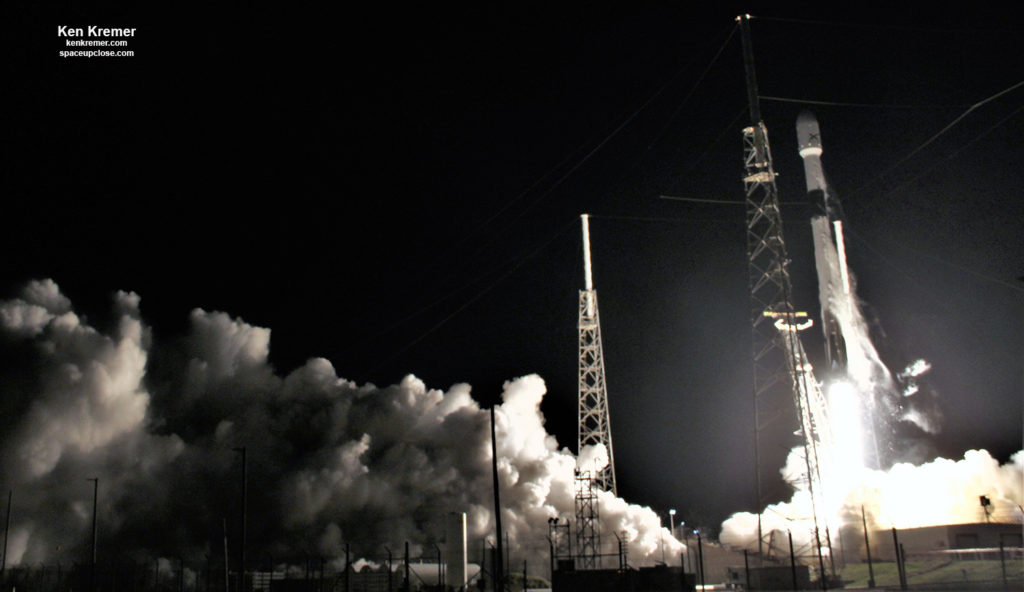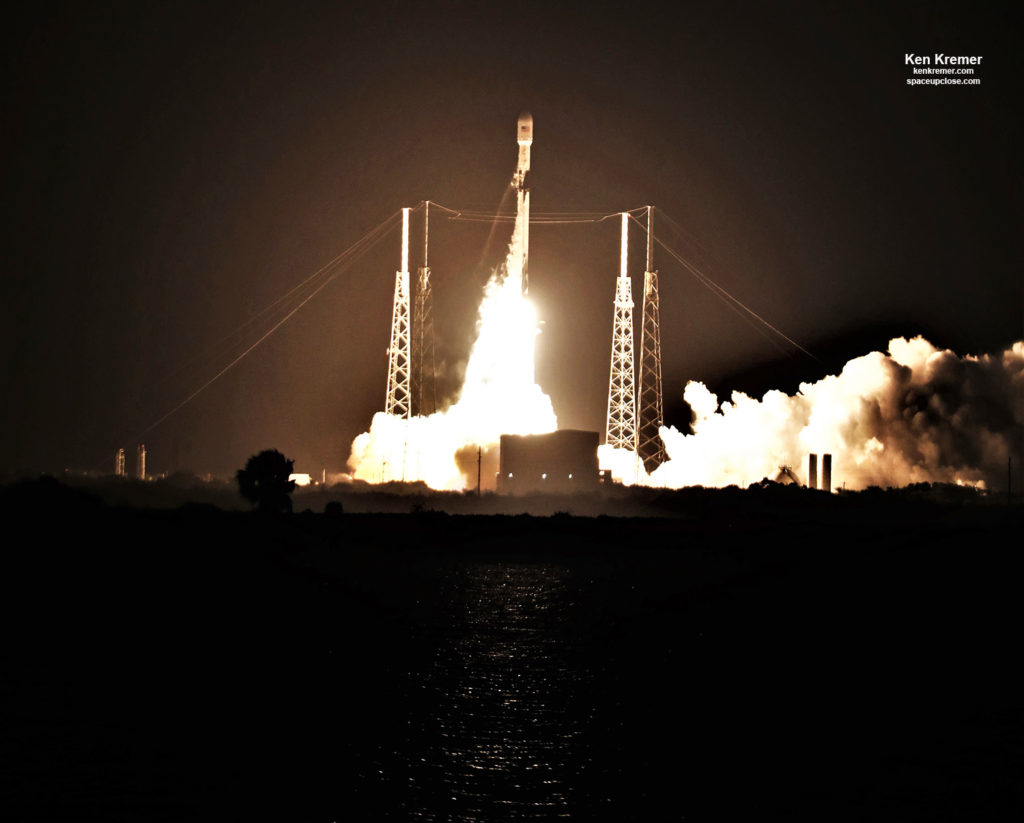Kremer — SpaceUpClose.com &
RocketSTEM – 23 May 2019
CAPE CANAVERAL AIR FORCE STATION, FL – The third time finally proved to be the charm
as the inaugural batch of 60 SpaceX Starlink broadband satellites finally lifted
off on the third try Thursday evening May 23 as the recycled Falcon 9 rocket
streaked to orbit to inaugurate a constellation of next generation of
satellites that will revolutionize the way the world accesses and uses the
internet in the next few years by slashing prices and broadening coverage to hard
to reach places across the globe.
At least that’s the hope and dream of put
forth by SpaceX CEO and billionaire founder Elon Musk for his planned network
of Low Earth orbiting (LEO) Starlink satellites that will eventually number in
the thousands to provide global broadband internet services to customers worldwide.
The Starlink satellite deployments took place
as planned approximately an hour after blastoff.
The Starlink 1 launch was scrubbed twice last
week – first for excessive and powerful upper levels winds which could destroy
the rocket on ascent through the atmosphere on the originally targeted date of
May 15. And second to fix a pesky software issue that was only discovered several
hours prior to the second attempt on May 16.
Liftoff of the Starlink 1 mission finally took place at 10:30
p.m. EDT Thursday, May 23 (0230 GMT Friday) from
Space Launch Complex-40 (SLC-40) on Cape Canaveral Air Force Station, FL.
The nighttime skies were mostly clear and offered a
stunning spectacle for spectators as Falcon thundered off the launch pad and
the engines roar crackled as loud as we’ve ever heard.
Enjoy our Space UpClose gallery of imagery from the launch
and prelaunch activities. Check back as the gallery grows.
Falcon 9 ignited at 10;30 p.m. EDT right at the opening of the 90 minute long launch
window with 1.7 million pounds of liftoff thrust spewing from the 9 Merlin 1D first
stage engines fueled by liquid oxygen and RP-1 propellants.
 |
|
9
Merlin 1D engines and 1 Gripper arm + Fire & Ice – Up Close look at SpaceX Falcon 9 Starlink 1 launch on 23 May 2019 at 1030 p.m. EDT from Space Launch Complex-40 on Cape Canaveral Air Force Station, FL that successfully delivered 1st 60 Starlink broadband satellites to LEO. Credit: Ken Kremer/kenkremer.com/spaceupclose.com |
The stages separated 2 minutes 34 seconds after
launch and the payload fairing halves opened and jettisoned 3 minutes 33
seconds after launch.
a precision rocket assisted intact and upright touchdown on the ‘Of Course I Still
Love You’ droneship prepositioned in the Atlantic Coast off the Carolinas.
This marks the third successful launch and landing for the first
stage booster.
Falcon 9’s first stage
for this mission previously supported the Telstar 18 VANTAGE mission in
September 2018 and the Iridium-8 mission in January 2019.
broadcast live on a SpaceX webcast.
fished out of the water by the SpaceX naval fleet.
Developing and building the first 60 Starlink
satellites “is one of the hardest engineering projects I’ve
ever seen done [and SpaceX has ever undertaken] and
its been executed really well,” Musk said as he outlined his
first detailed vision of the firms Starlink broadband constellation in a media conference
call on May 15 – just hours prior to the original target launch date that eventually
was scrubbed minutes before liftoff due to powerful upper altitude winds.
“The goal of the Starlink system is to provide
high bandwidth, low latency connectivity, ideally throughout the world that will offer an alternative to expensive services
and also provide internet options to places where no connectivity is currently
available.”
However the entire concept of Starlink remains highly
experimental.
“I think it is important to acknowledge that
there is a lot of new technology here. So it’s possible that some of these
satellites may not work. In fact, there’s a small possibility that all of the
satellites will not work,” Musk explained during the telecon.
“We don’t want to count anything until it’s
hatched, but these are, I think, a great design and we’ve done everything we
can to maximize the probability of success.”
 |
| Credit: Ken Kremer/kenkremer.com/spaceupclose.com |
have worked Musk noted, citing the original Iridium broadband version 1 system “which
did not succeed.”
“It is very
difficult and far from a sure thing.”
Nevertheless Musk’s team is aspiring to make Starlink a huge success.
More than 1000 satellites must be orbited to get good coverage – which
is initially aimed for the US Market.
That will require more than 15 Falcon 9 launches – of which
Starlink 1 is the maiden mission to get the program literally off the
ground.
They will maneuver, maintain altitude and deorbit using Hall thrusters. The ion thruster are powered
by Krypton gas – as opposed to Xenon.
“The Starlink mission will be the heaviest SpaceX
payload ever at 18.5 tons for either the Falcon 9 or Falcon Heavy.”
Each Starlink satellite weighs approximately 227 kg (500 pounds) for a
total mass of 13,600 kg (29964 pounds).
The Starlink satellites were successfully deployed starting
approximately one hour and two minutes after liftoff – at an altitude of 440 kilometers (273 mi).
They will now use the onboard Krypton ion thrusters as propulsion
to reach the operational altitude of 550 km (342 mi)– that’s lower than SpaceX
initially planned 1,150 km (741 mi) altitude.
The Starlink satellites feature a flat-panel
design with multiple high-throughput antennas and a single solar array. They
are mass produced in SpaceX’s Redmond, Washington facility.
“When you add all the solar panels together
the output is about 50% more than the solar arrays on the International Space
Station,” said Musk.
Initially Starlink will be aimed at the US
market where regulatory approval has been received from the U.S. Federal Communications Commission. Then it will spread
to the rest of the world.
Musk says that 6 more launches of about 60
satellites each will be required to enable initial coverage and start service in the US.
That involves 7 launches and approximately
420 Starlink satellites.
dozen launches.
coverage and 30 for nearly complete worldwide service.
Watch my SpaceX launch commentary and rocket photos at this Fox 35
Orlando report from May 16 launch attempt:
http://www.fox35orlando.com/home/spacex-trying-again-for-launch-of-falcon-9-rocket
 |
|
Dr. Ken Kremer/Space UpClose commentary about SpaceX
Starlink-1 launch with Fox 35 WOFL Orlando TV News |
Watch for Ken’s continuing
onsite coverage of NASA, SpaceX, ULA, Boeing, Lockheed Martin, Northrop Grumman
and more space and mission reports direct from the Kennedy Space Center, Cape
Canaveral Air Force Station, Florida and Wallops Flight Facility, Virginia.
Planetary science and human spaceflight news: www.kenkremer.com –www.spaceupclose.com – twitter @ken_kremer
– email: ken at kenkremer.com
Dr. Kremer is a research scientist and journalist based in the
KSC area, active in outreach and interviewed regularly on TV and radio about
space topics.
………….
Ken’s photos are for sale and he is available for lectures and outreach events




